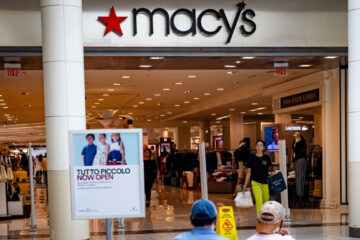Many of us who look after our health and fitness probably wear a fitness tracking device.
Whether we prefer to wear it during a workout only or at all times of the day, these handy devices have become central to many of our personal data gathering initiatives, and for good reason.
Related: Popular shoe brand takes aim at Nike
Many of these devices are worn as watches or rings. They’re simple enough to pass for everyday accessories but are far more capable.
Apple’s (AAPL) Watch is the most popular on the market, partly because it integrates so seamlessly with its iOS system and allows users to text, email, take and make phone calls, and track their fitness on one watch interface.
Its most recent model, the Ultra 2, boasts an impressive list of features and capabilities, including:
Precise altitude and depth measurementsWater resistance up to 100 metersPrecise GPS tracking capabilitiesTitanium caseBiggest and brightest Apple Watch displayLonger battery life (up to 36 hours with regular use)Sleep estimates and measurementsHeart rateMedication remindersMindfulness remindersCycle trackingStep countCalories burnedEmail, iMessage, and phone call capabilities
And all that convenience packed into one device is popular. Apple has sold over 229 million watches since mid-2023. It’s one of the most popular wearable devices since it seamlessly tracks fitness, scheduling, and networking all in one device for a starting price of $799 for Ultra 2.
The Apple Watch is displayed at an Apple Store in Corte Madera, Calif.
Justin Sullivan/Getty Images
Apple Watch has plenty of competitors
And while its Watch is wildly popular, it’s certainly not the only fitness tracker on the market.
Other popular devices include the Oura Ring, a ring which uses red and green LED light sensors to pick up measurements through a wearer’s skin, including:
Heart rate variation (HRV)Respiratory rateBlood oxygen levelsSleep qualityBody temperatureRecovery and stressActivity
Garmin also offers several capable and impressive watch models, and WHOOP offers a wearable wrist band – no screen included, though.
Related: Former Home Depot CEO issues stark warning about the economy
Fitbit releases new wearable
Most of these devices have one thing in common, though. They’re squarely aimed at mature teens and adults.
An all new Fitbit wearable watch, however, promises to change that.
More Retail:
Ulta CEO sounds the alarm on a growing problemLululemon releases a first-of-its-kind productTarget store introduces a new ‘over 18’ policyAmazon launches genius new subscription product
The connected device company released the Fitbit Ace LTE in late May, a watch which features a square screen design and retails for $229.95.
The FitBit Ace LTE also includes some fun and pragmatic features, including:
Durable, plastic materialsPhysical activity recognition, including play timeInteractive 3D games on screen that encourages more movementGPS tracking for parentsCustomizable characters called EejiesClosable “Noodle” loop to encourage daily activity goalsCompatible with Fitbit Ace App, which allows parents or guardians to call, send and receive text and voice messagesWater resistant up to 50 meters
Fitbit says in a couple of months it will also be adding a tap to pay feature for kids who want to purchase things with “pocket money,” on the go.
Introducing the Fitbit Ace LTE, the first @Fitbit kids smartwatch that lets them call, chat and play — available June 5. Parents, learn more about our latest device ↓ https://t.co/PvMGPADyAT
— Google (@Google) May 29, 2024
Fitbit, which is owned by Alphabet’s (GOOG) Google, also insists the device is safe for kids and parents.
“We worked with leading, independent experts in child psychology, public health, privacy and digital wellbeing to design Fitbit Ace LTE to be fun, safe and helpful,” Google writes of the product launch. “It’s built with privacy in mind, front and center. For example, only parents are ever shown a child’s location or activity data in their app, location data is deleted after 24 hours and activity data is deleted after a maximum of 35 days. There are no ads or third-party apps, and only contacts added by a parent can call or message the device.”
Related: Veteran fund manager picks favorite stocks for 2024


